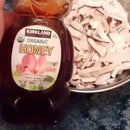Introduction: Raku Pottery
In my material science class the entire class made raku pots when we were studying ceramics. unlike most pottery, there is actual elemental metal in the glaze of the finished product.
most glazes just have oxidized metals and their color comes from those, but in raku pots the metal is reduced from oxidized to the elemental state of the metal so some of the color on the pot is actual metal. in the pots i made i put a lot of Copper Carbonate
IMPORTANT NOTE- You must be very careful and save when you are handling high temperature pots and working with kilns. Please have an adult help you if you are not one yet, and please use a facemask and the correct gloves and crucible tongs for the project. Safe playing is happy playing.
Step 1: Materials and Tools
You will need
-Raku pot clay or just high temperature clay
-Glaze base
-Metal oxides like copper, tin, cobalt, and iron oxide to make your glazes
-Kiln yours, a friends, or a potters
-Brushes, a can, tongs, and high temperature gloves better then welding gloves
-You will also need saw dust and shredded paper
Step 2: Form Your Pot
This is part of the way where you can make this completely yours. i just made a hole in a rod of the clay and then widened the bottom. i then squished in the neck to make it very small and widened the top to have a big lip.
you can do this however you want and there are multiple tutorials on how to make any type of pot.
Also you must use a type of clay that is specifically for raku, or a clay that can stand rapid cooling without shattering. we used two different kinds of clays one that was definitely for raku and one that should handle the temperature changes.
Step 3: Fire for the First Time
Your pot is now called greenware. It will fall apart in water because it had not been fired yet. Fire the pots in your own kiln or use a friends. Or you could take it to a potter and they will probably be able to fire it for you for a small price. also make a couple of small pieces of extra clay so that you can test your glazes. Ramp the kiln with the pots in it to 105 C for one hour then ramp to 900 C for 15 minutes then let it cool slowly.
Step 4: Glaze
To make your glaze you must acquire some glaze base, then you add about 3% metal oxides by mass to make the glazes of your choice.
(Metal oxide- metal, oxidized, reduced, percent metal in glaze)
CoO2- Cobalt, deep blue, gray, 3%
SnO2- Tin, white, gray, 3%
CuO- Copper, light green, 3%
CuCO3- Copper, green, copper, 3%
FeO3- Iron, straw yellow, gray, 1%
FeO3- Iron, orange/brown, gray 3%
FeO3- Iron, brown, gray, 7%
MnO2- Manganese, light yellow/brown, gray, 3%
After you make your glazes you can test them out to find their exact colors on the test pieces of clay that you made. Color may very based on type of clay, amount of metal oxide, type of glaze, and the amount of reduced metal.
Step 5: Glaze Your Pot
After you have found the colors you want then you can now glaze your pot. do three thin layers of glaze and let the glaze dry before another coat. Traditionally these raku pots are not a single color but rather they are many colors all mixed together on your pot to make a variety of colors and reduced metals.
Step 6: Fire Again
Now fire your pot again at 1000-1050 C for 30 minutes to an hour at that temperature and then take it out and drop it into a can is just over half way full of shredded paper and sawdust, let it burn for a couple seconds then replace the lid and take it outside to burn and cool down. When cool, or after about 15 minutes take out and place in lukewarm water to cool further. There should still be a lot of paper and sawdust in the can.
This process introduces the molten glaze to burning paper which makes an Carbon rich environment that then reacts with the oxygen in the metal oxides to make CO2 which reduced the metal oxides to the elemental metal so the color of the metal shows up. Copper is reduced most easily but some of the other metal colors, mostly grays and silvers will also show up in places on your pot.
Step 7: Finish
Now let it cool completely and take a scouring pad to the pot to shine the surfaces and remove the soot from the sawdust. Now you can go show your cool pot to all your friends and family and i am sure it will be a hit.
I hope you enjoy this instructable and i hope you go make a raku pot
Please comment below if you liked it or have any other ideas or concerns and check out my other instructables on my page.

Participated in the
Crafting 101














